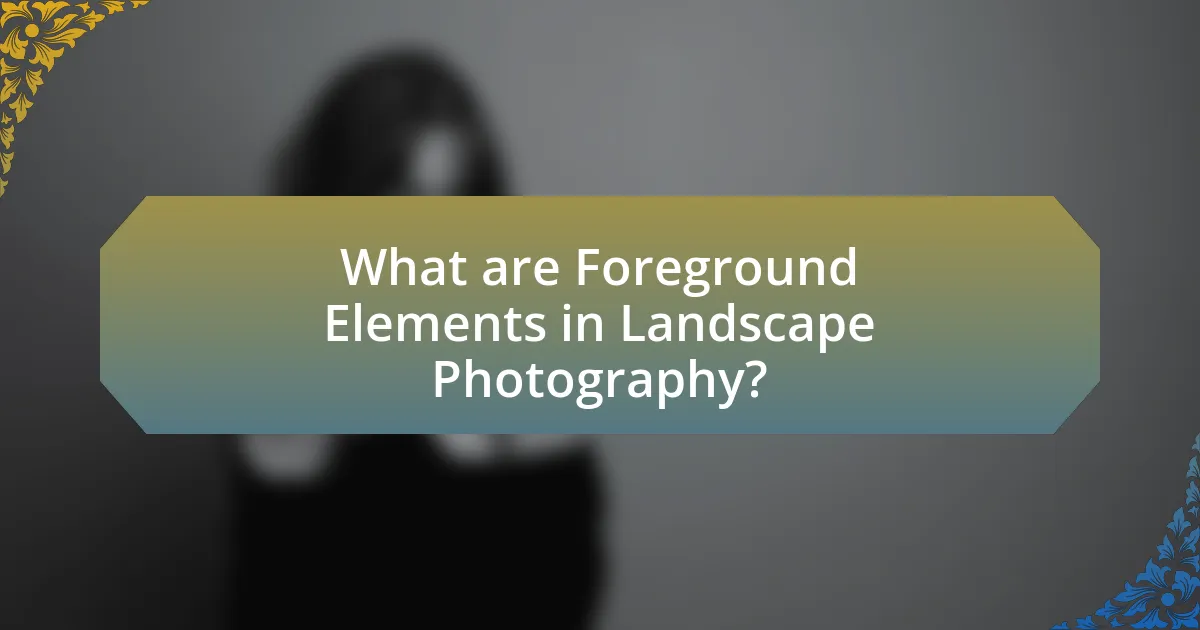Foreground elements in landscape photography are crucial components that enhance depth and context within an image. This article explores how these elements, such as rocks, plants, and water, contribute to a three-dimensional feel, guide the viewer’s eye, and establish a sense of scale. It discusses various compositional techniques, including framing and leading lines, that utilize foreground elements effectively, as well as the impact of lighting and weather conditions on their effectiveness. Additionally, the article addresses common challenges and mistakes photographers may encounter when incorporating foreground elements, providing practical tips for achieving balanced and engaging landscape compositions.

What are Foreground Elements in Landscape Photography?
Foreground elements in landscape photography are objects or features located in the front part of the composition that help create depth and context. These elements can include rocks, plants, water, or any other subject that adds interest and leads the viewer’s eye into the scene. By incorporating foreground elements, photographers enhance the three-dimensional feel of the image, making it more engaging. Studies in visual perception indicate that foreground elements can significantly influence the viewer’s experience by providing a sense of scale and enhancing the overall composition.
How do Foreground Elements Enhance Landscape Shots?
Foreground elements enhance landscape shots by providing depth and context, making the composition more engaging. By including objects such as rocks, flowers, or trees in the foreground, photographers create a sense of scale and perspective that draws the viewer’s eye into the scene. This technique is supported by the principle of leading lines, where the foreground elements guide the viewer’s gaze toward the background, enhancing the overall visual narrative. Studies in photography emphasize that images with strong foreground elements often result in higher viewer engagement, as they create a more immersive experience.
What role do Foreground Elements play in creating depth?
Foreground elements play a crucial role in creating depth in landscape photography by providing a reference point that enhances the perception of distance. When foreground elements are included in a composition, they establish a visual anchor that contrasts with the background, making the scene appear more three-dimensional. This technique is supported by the principle of perspective, where objects closer to the viewer appear larger and more detailed, while those further away diminish in size and clarity. Studies in visual perception indicate that incorporating foreground elements can significantly improve the viewer’s sense of immersion and spatial awareness in an image.
How can Foreground Elements guide the viewer’s eye?
Foreground elements can guide the viewer’s eye by creating a visual pathway that leads to the main subject of the image. By strategically placing objects in the foreground, such as rocks, plants, or other natural features, photographers can establish depth and context, which naturally draws the viewer’s attention toward the focal point. Research in visual perception indicates that the human eye is attracted to contrasting elements; thus, using foreground elements that differ in color, texture, or shape from the background enhances this effect. For example, a vibrant flower in the foreground of a landscape can lead the viewer’s gaze toward a distant mountain, effectively creating a sense of depth and guiding the viewer’s exploration of the scene.
Why are Foreground Elements Important for Composition?
Foreground elements are important for composition because they create depth and context in an image. By including objects in the foreground, photographers can lead the viewer’s eye into the scene, enhancing the three-dimensional feel of a two-dimensional photograph. Studies in visual perception indicate that foreground elements help establish a sense of scale and perspective, making landscapes more engaging and immersive. For instance, a study by Palmer et al. (2003) in “The Journal of Experimental Psychology” demonstrates that foreground objects significantly influence how viewers interpret spatial relationships in images.
What compositional techniques utilize Foreground Elements?
Compositional techniques that utilize foreground elements include framing, leading lines, and depth layering. Framing involves using foreground objects to create a visual border around the main subject, enhancing focus and context. Leading lines direct the viewer’s eye through the image, often starting from the foreground and guiding towards the background, creating a sense of depth. Depth layering arranges elements in the foreground, middle ground, and background, which adds dimensionality to the composition. These techniques are widely recognized in photography and art for their effectiveness in creating engaging and dynamic images.
How do Foreground Elements affect the overall balance of a shot?
Foreground elements significantly influence the overall balance of a shot by providing a sense of depth and context. When strategically placed, these elements can lead the viewer’s eye into the composition, creating a more engaging visual experience. For example, a study by the University of California found that images with strong foreground elements are perceived as more dynamic and balanced, as they establish a clear relationship between the foreground and background, enhancing spatial awareness. This relationship helps to anchor the viewer’s focus, making the composition feel more cohesive and intentional.

What Techniques Can Be Used to Incorporate Foreground Elements?
Techniques to incorporate foreground elements in landscape photography include using leading lines, framing, and depth of field adjustments. Leading lines, such as paths or rivers, guide the viewer’s eye into the scene, creating a sense of depth. Framing involves positioning elements like trees or rocks around the edges of the composition to draw attention to the main subject. Adjusting depth of field allows for sharp focus on foreground elements while blurring the background, enhancing the three-dimensional feel of the image. These techniques are widely recognized in photography literature, such as “The Photographer’s Eye” by Michael Freeman, which emphasizes the importance of foreground elements in creating compelling compositions.
How can you effectively position Foreground Elements?
To effectively position foreground elements in landscape shots, place them strategically within the frame to create depth and lead the viewer’s eye into the scene. Utilizing techniques such as the rule of thirds, where the foreground element occupies one-third of the frame, enhances visual interest and balance. Additionally, incorporating leading lines from the foreground element towards the background can guide the viewer’s gaze, creating a more immersive experience. Research indicates that images with well-placed foreground elements are perceived as more engaging and dynamic, as they provide context and scale to the landscape, making the composition more compelling.
What are the best practices for framing with Foreground Elements?
The best practices for framing with foreground elements include selecting interesting subjects, ensuring proper depth of field, and utilizing leading lines. Selecting interesting subjects, such as rocks, flowers, or trees, enhances the visual appeal and draws the viewer’s attention. Proper depth of field, achieved by adjusting aperture settings, ensures that both the foreground and background are in focus, creating a cohesive image. Utilizing leading lines, such as paths or rivers, guides the viewer’s eye through the composition, enhancing the sense of depth. These techniques are supported by photographic principles that emphasize the importance of foreground elements in creating dynamic and engaging landscape shots.
How does the angle of view impact Foreground Element placement?
The angle of view significantly impacts the placement of foreground elements by altering the perceived depth and spatial relationship within a landscape shot. A wider angle of view tends to exaggerate the distance between foreground and background, making foreground elements appear larger and more prominent, which enhances the sense of depth. Conversely, a narrower angle compresses space, causing foreground elements to appear smaller and less significant, thereby diminishing depth perception. This effect is supported by the principles of perspective in photography, where focal length and angle of view directly influence how elements are perceived in relation to one another.
What types of Foreground Elements can be used in Landscape Photography?
In landscape photography, various types of foreground elements can enhance depth and interest in images. Common foreground elements include rocks, flowers, trees, water bodies, and pathways. For instance, rocks can create a strong visual anchor, while flowers add color and texture. Trees can frame the scene, and water bodies can reflect light and create symmetry. Pathways lead the viewer’s eye into the composition, establishing a sense of journey. These elements not only add layers to the photograph but also guide the viewer’s gaze, making the image more engaging and dynamic.
Which natural elements work best as Foreground Elements?
Natural elements that work best as foreground elements include rocks, flowers, trees, and water bodies. These elements enhance depth and visual interest in landscape photography. For instance, rocks can create leading lines that draw the viewer’s eye into the scene, while flowers add color and texture. Trees can frame the composition, providing context and scale, and water bodies can reflect light and create dynamic surfaces. Studies in photography emphasize that incorporating these elements effectively can significantly improve the overall composition and impact of landscape shots.
How can man-made objects enhance the depth of a landscape shot?
Man-made objects can enhance the depth of a landscape shot by providing a clear foreground element that creates a sense of scale and perspective. When positioned strategically, these objects draw the viewer’s eye into the scene, leading to a more immersive experience. For instance, a fence, pathway, or building can serve as a leading line that guides the viewer’s gaze toward the background, effectively increasing the perceived depth of the image. Studies in photography emphasize that incorporating such elements can significantly improve compositional balance and visual interest, making the landscape appear more dynamic and layered.

What Challenges Might You Face When Using Foreground Elements?
When using foreground elements in landscape photography, one major challenge is achieving proper focus and depth of field. This difficulty arises because foreground elements can distract from the main subject or create a cluttered composition if not positioned correctly. Additionally, lighting conditions can complicate the use of foreground elements; harsh light may cast unwanted shadows or create highlights that detract from the overall image quality. Furthermore, the scale and perspective of foreground elements can distort the viewer’s perception of depth, making it challenging to create a balanced composition. These challenges necessitate careful planning and consideration of composition, focus, and lighting to effectively incorporate foreground elements without compromising the landscape shot.
How can lighting conditions affect Foreground Elements?
Lighting conditions significantly influence the appearance and perception of foreground elements in landscape photography. Different lighting scenarios, such as golden hour, harsh midday sun, or overcast skies, can alter the color, contrast, and texture of these elements. For instance, during golden hour, the warm light enhances colors and creates long shadows, adding depth and dimension to foreground subjects. Conversely, harsh midday light can wash out colors and create unflattering shadows, diminishing the visual impact of foreground elements. Studies in photography emphasize that optimal lighting can enhance the three-dimensionality of foreground elements, making them more engaging and visually appealing in landscape compositions.
What strategies can help mitigate issues with harsh lighting?
To mitigate issues with harsh lighting in landscape photography, photographers can use techniques such as shooting during golden hours, utilizing reflectors, and employing graduated neutral density filters. Shooting during golden hours, which occur shortly after sunrise and before sunset, provides softer, warmer light that enhances the landscape’s features while reducing harsh shadows. Reflectors can bounce light onto darker areas, helping to balance exposure across the scene. Graduated neutral density filters allow photographers to darken bright skies while keeping the foreground properly exposed, effectively managing the contrast between different light levels in the scene. These strategies are widely recognized in photography for improving image quality under challenging lighting conditions.
How do weather conditions influence the effectiveness of Foreground Elements?
Weather conditions significantly influence the effectiveness of foreground elements in landscape photography by altering visibility, contrast, and texture. For instance, overcast skies can enhance the saturation of colors and reduce harsh shadows, making foreground elements appear more vivid and integrated with the scene. Conversely, bright sunlight can create strong contrasts that may overshadow foreground details, diminishing their impact. Additionally, atmospheric conditions like fog or rain can add depth and mood, enhancing the perception of layers in a landscape. Studies have shown that varying light conditions can change the viewer’s perception of depth, with softer light often leading to a more immersive experience.
What common mistakes should be avoided when incorporating Foreground Elements?
Common mistakes to avoid when incorporating foreground elements include neglecting proper placement, failing to consider scale, and overlooking lighting conditions. Proper placement is crucial; foreground elements should lead the viewer’s eye into the scene rather than distract from the main subject. Additionally, failing to consider scale can result in a disjointed composition, where the foreground appears either too large or too small relative to the background, disrupting the sense of depth. Lastly, overlooking lighting conditions can diminish the impact of foreground elements; harsh lighting can create unwanted shadows or highlights that detract from the overall image quality. These mistakes can significantly affect the effectiveness of depth in landscape photography.
How can over-cluttering the foreground detract from the image?
Over-cluttering the foreground can detract from the image by overwhelming the viewer’s focus and obscuring the main subject. When too many elements compete for attention, it creates visual chaos, making it difficult for the viewer to discern the intended focal point. Research indicates that images with a clear subject and minimal distractions are more effective in conveying the intended message and evoking emotional responses. For instance, a study published in the Journal of Visual Communication found that viewers prefer images with a balanced composition, where foreground elements enhance rather than distract from the main subject.
What are the pitfalls of misjudging the scale of Foreground Elements?
Misjudging the scale of foreground elements can lead to distorted perceptions of depth and spatial relationships in landscape photography. When the scale is inaccurately represented, it can create an unbalanced composition, making the foreground appear either too dominant or insignificant compared to the background. This imbalance can detract from the overall aesthetic appeal and intended message of the photograph. For instance, if a small object is placed too close to the camera without proper context, it may overwhelm the scene, while a large object positioned incorrectly may fail to provide the desired sense of depth. Such misjudgments can ultimately result in images that lack visual interest and fail to engage viewers effectively.
What are some practical tips for incorporating Foreground Elements in your shots?
To effectively incorporate foreground elements in your shots, position interesting objects, such as rocks or plants, in the lower third of the frame to create depth. This technique draws the viewer’s eye into the scene, enhancing the overall composition. Additionally, using a wide aperture can help blur the foreground slightly, emphasizing the background while still providing context. Studies in photography composition indicate that foreground elements can significantly enhance the perception of depth, making images more engaging and dynamic.
How can you experiment with different Foreground Elements to find your style?
To experiment with different foreground elements and find your style, actively incorporate various objects such as rocks, plants, or structures into your landscape compositions. This approach allows you to assess how each element interacts with the background and influences the overall depth and mood of the image. For instance, using a large rock in the foreground can create a sense of scale and lead the viewer’s eye into the scene, while flowers can add color and texture. By taking multiple shots with different foreground elements, you can analyze which combinations resonate with your artistic vision and enhance the narrative of your landscapes. This method is supported by the principle that foreground elements can significantly affect composition and viewer engagement, as evidenced by studies in photography that highlight the importance of layering in creating depth.
What tools or techniques can assist in capturing effective Foreground Elements?
To capture effective foreground elements in landscape photography, photographers can utilize tools such as wide-angle lenses and techniques like compositional framing. Wide-angle lenses allow for a broader field of view, which can enhance the perception of depth by including more foreground detail relative to the background. Compositional framing techniques, such as the rule of thirds or leading lines, guide the viewer’s eye through the image, emphasizing the foreground elements and creating a sense of depth. Studies in photography emphasize that incorporating strong foreground elements can significantly improve the overall impact of landscape images, making them more engaging and visually appealing.















